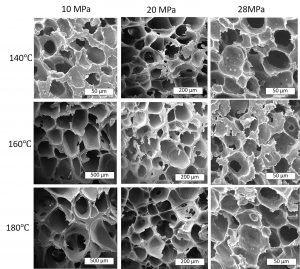Jun 30 2021
Biodegradable plastics are meant to be environmentally friendly. However, they cannot be recycled as they are specifically made to degrade rapidly.
 Foam structure for various temperatures and pressures. The bulkiest foams have the largest air pockets and are good for flotation devices. Image Credit: Heon Park.
Foam structure for various temperatures and pressures. The bulkiest foams have the largest air pockets and are good for flotation devices. Image Credit: Heon Park.
In the journal Physics of Fluids, by AIP Publishing, scientists from the University of Canterbury in New Zealand have designed a technique to convert biodegradable plastic forks, spoons and knives into foam that can be utilized as insulation in flotation devices or walls.
The cutlery was positioned by the investigators, which was earlier believed to be a “nonfoamable” plastic, into a chamber loaded with carbon dioxide. With the increase in pressure, the gas dissolved into the plastic.
When the pressure in the chamber was suddenly discharged, the carbon dioxide expanded inside the plastic, thereby creating foaming. According to author Heon Park, this process is similar to opening a can of soda and discharging the carbonation.
Tweaking temperature and pressure, there is a window where we can make good foams. It’s not that every temperature or every pressure works. We found what temperature or what pressure is the best to make those nonfoamable plastics into foams.
Heon Park, Study Author, University of Canterbury
Some amount of strength is lost by the plastic every time it is recycled. Foams are a perfect new material since they don't need to be strong in the majority of applications.
Whenever we recycle, each time, we degrade the plastics. Let’s say we have a biodegradable spoon. We use it once, and we recycle it back into another spoon. It may break in your mouth.
Heon Park, Study Author, University of Canterbury
The perfect structure of a foam is based on its ultimate use. Heavy foams, which have large or abundant air pockets, are considered good for buoys. In contrast to what was thought earlier, the scientists found that lower chamber pressures resulted in bulky foams.
Recycling biodegradable plastics could mitigate a few of the pollution issues worldwide. Ultimately, although biodegradable material ultimately disintegrates in nature, recycling plastics is much better for the environment.
Recyclable and biodegradable plastics can be utilized more than once but are also less of an environmental risk if they end up in landfills or oceans. The researchers believe this process could be executed on a large scale.
We can expand foaming applications to a lot of plastics, not just this plastic.
Heon Park, Study Author, University of Canterbury
Journal Reference:
Lin, L., et al. (2021) Recycling and rheology of poly(lactic acid) (PLA) to make foams using supercritical fluid. Physics of Fluids. doi.org/10.1063/5.0050649.